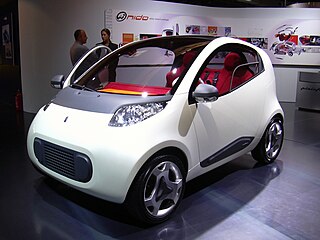
A hybrid vehicle is one that uses two or more distinct types of power, such as submarines that use diesel when surfaced and batteries when submerged. Other means to store energy include pressurized fluid in hydraulic hybrids.

The Restriction of Hazardous Substances Directive 2002/95/EC, short for Directive on the restriction of the use of certain hazardous substances in electrical and electronic equipment, was adopted in February 2003 by the European Union.

A compressed-air vehicle (CAV) is a transport mechanism fueled by tanks of pressurized atmospheric gas and propelled by the release and expansion of the gas within a pneumatic motor.

The European Research Area (ERA) is a system of scientific research programs integrating the scientific resources of the European Union (EU). Since its inception in 2000, the structure has been concentrated on European cooperation in the fields of medical, environmental, industrial, and socioeconomic research. The ERA can be likened to a research and innovation equivalent of the European "common market" for goods and services. Its purpose is to increase the competitiveness of European research institutions by bringing them together and encouraging a more inclusive way of work, similar to what already exists among institutions in North America and Japan. Increased mobility of knowledge workers and deepened multilateral cooperation among research institutions among the member states of the European Union are central goals of the ERA.
The Framework Programmes for Research and Technological Development, also called Framework Programmes or abbreviated FP1 to FP9, are funding programmes created by the European Union/European Commission to support and foster research in the European Research Area (ERA). Starting in 2014, the funding programmes were named Horizon.
The European Institute of Innovation and Technology (EIT) is an independent body of the European Union with juridical personality, established in 2008 intended to strengthen Europe's ability to innovate. The EIT’s three “core pillars” of activities are: entrepreneurial education programmes and courses across Europe that transform students into entrepreneurs; business creation and acceleration services that scale ideas and budding businesses; and innovation-driven research projects that turn ideas into products by connecting partners, investors, and expertise.

European Grid Infrastructure (EGI) is a series of efforts to provide access to high-throughput computing resources across Europe using grid computing techniques. The EGI links centres in different European countries to support international research in many scientific disciplines. Following a series of research projects such as DataGrid and Enabling Grids for E-sciencE, the EGI Foundation was formed in 2010 to sustain the services of EGI.

A biocomposite is a composite material formed by a matrix (resin) and a reinforcement of natural fibers. Environmental concern and cost of synthetic fibres have led the foundation of using natural fibre as reinforcement in polymeric composites. The matrix phase is formed by polymers derived from renewable and nonrenewable resources. The matrix is important to protect the fibers from environmental degradation and mechanical damage, to hold the fibers together and to transfer the loads on it. In addition, biofibers are the principal components of biocomposites, which are derived from biological origins, for example fibers from crops, recycled wood, waste paper, crop processing byproducts or regenerated cellulose fiber (viscose/rayon). The interest in biocomposites is rapidly growing in terms of industrial applications and fundamental research, due to its great benefits. Biocomposites can be used alone, or as a complement to standard materials, such as carbon fiber. Advocates of biocomposites state that use of these materials improve health and safety in their production, are lighter in weight, have a visual appeal similar to that of wood, and are environmentally superior.

In 2015, 43.5% of the United Kingdom's municipal waste was recycled, composted or broken down by anaerobic digestion. The majority of recycling undertaken in the United Kingdom is done by statutory authorities, although commercial and industrial waste is chiefly processed by private companies. Local Authorities are responsible for the collection of municipal waste and operate contracts which are usually kerbside collection schemes. The Household Waste Recycling Act 2003 required local authorities in England to provide every household with a separate collection of at least two types of recyclable materials by 2010. Recycling policy is devolved to the administrations of Scotland, Northern Ireland and Wales who set their own targets, but all statistics are reported to Eurostat.

An electric vehicle battery is a rechargeable battery used to power the electric motors of a battery electric vehicle (BEV) or hybrid electric vehicle (HEV).
The European Technology Platform on Smart Systems Integration (EPoSS) is a collaborative initiative under the European Seventh Framework Programme, dedicated to enhancing the European Union's position in Smart Systems Technologies and integrated Micro and Nanosystems. Established as a Public-Private Partnership between the European Commission and various industry players, EPoSS aims to define research and development (R&D) needs and policy requirements in these cutting-edge fields.
The End of Life Vehicles Directive is a Directive of the European Union addressing the end of life for automotive products. Every year, motor vehicles which have reached the end of their useful lives create between 8 and 9 million tonnes of waste in the European Union. In 1997, the European Commission adopted a Proposal for a Directive to tackle this problem.

A circular economy is a model of resource production and consumption in any economy that involves sharing, leasing, reusing, repairing, refurbishing, and recycling existing materials and products for as long as possible. The concept aims to tackle global challenges such as climate change, biodiversity loss, waste, and pollution by emphasizing the design-based implementation of the three base principles of the model. The three principles required for the transformation to a circular economy are: designing out waste and pollution; keeping products and materials in use, and regenerating natural systems." CE is defined in contradistinction to the traditional linear economy. The idea and concepts of a circular economy have been studied extensively in academia, business, and government over the past ten years. It has been gaining popularity because it can help to minimize carbon emissions and the consumption of raw materials, open up new market prospects, and, principally, increase the sustainability of consumption.
Sustainable products are products who are either sustainability sourced, manufactured or processed that provide environmental, social and economic benefits while protecting public health and environment over their whole life cycle, from the extraction of raw materials until the final disposal.

The Clean Sky Joint Undertaking (CSJU) is a public-private partnership between the European Commission and the European aeronautics industry that coordinates and funds research activities to deliver significantly quieter and more environmentally friendly aircraft. The CSJU manages the Clean Sky Programme (CS) and the Clean Sky 2 Programme (CS2), making it Europe's foremost aeronautical research body.

The Pininfarina Nido is a concept car designed by Pininfarina and introduced at the 2004 Paris Motor Show. In Italian, the word Nido means nest, in fact the single-box shape of the car conveys an impression of a protective nest surrounding the occupants.

Usage of electric cars damage people’s health and the environment less than similar sized internal combustion engine cars. While aspects of their production can induce similar, less or different environmental impacts, they produce little or no tailpipe emissions, and reduce dependence on petroleum, greenhouse gas emissions, and deaths from air pollution. Electric motors are significantly more efficient than internal combustion engines and thus, even accounting for typical power plant efficiencies and distribution losses, less energy is required to operate an electric vehicle. Manufacturing batteries for electric cars requires additional resources and energy, so they may have a larger environmental footprint in the production phase. Electric vehicles also generate different impacts in their operation and maintenance. Electric vehicles are typically heavier and could produce more tire and road dust air pollution, but their regenerative braking could reduce such particulate pollution from brakes. Electric vehicles are mechanically simpler, which reduces the use and disposal of engine oil.

The European Defence Fund (EDF) is a component of the European Union's (EU) Common Security and Defence Policy (CSDP) which aims to coordinate and increase national investment in defence research and improve interoperability between national armed forces. It was proposed in 2016 by Commission President Jean-Claude Juncker and established in 2017. The fund has two stands; Research and Development & Acquisition. In July 2018, the European Commission announced that the EDF budget for 2021-2027 would be €13 billion. This sum was later revised by the European Commission as part of the new EU budget proposed on May 27, 2020, as a result of the COVID-19 pandemic, according to which the EDF will be allocated €8 billion over this budget period.

The Directorate-General for Defence Industry and Space is a department of the European Commission.
The European Battery Alliance (EBA) is Europe's plan to create its own competitive and sustainable battery cell manufacturing value chain. Its purpose is to ensure that Europe benefits from the technological evolution in the Electric Vehicle Market and beyond. The action plan includes cleaner and more sustainable vehicles as well as safer traffic operations across Europe.











